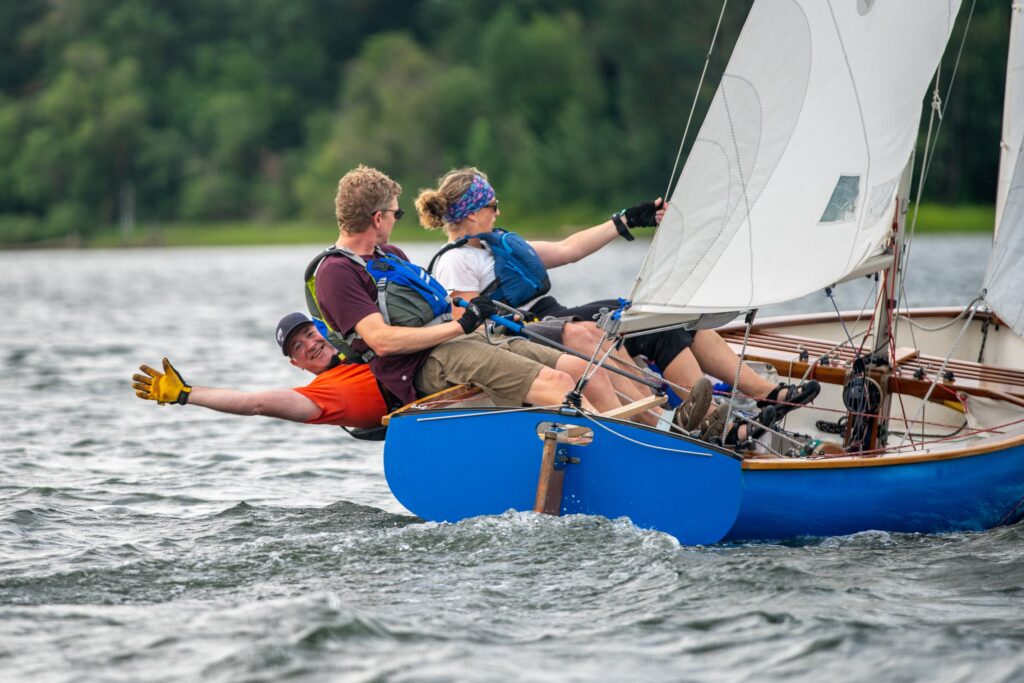If you’ve ever driven across the Ross Island Bridge and looked south, you might’ve seen them — a fleet of tiny white triangle-shaped sailboats zigzagging back and forth like someone lit their sails on fire. It looks aimless. Disorganized. Like a miniature regatta gone rogue.
It’s not. It’s supposed to look like that. It’s chaos with a purpose.
Every Wednesday evening during the summer, a group of dinghy sailors — some seasoned racers, some just figuring it out — harness the evening wind on the Willamette River and race with precision. What looks like chaos is actually the
Willamette Sailing Club
’s summer Wednesday night races.
The races, which can include up to 50 dinghies, are held on the west side of Ross Island, just five minutes south of downtown Portland. Sailors compete in four classes of dinghies — Lasers, Thistles, Lido 14s and day sailers — each less than 20 feet long and each with distinct advantages and limitations.
Lasers are fast, agile boats sailed solo. They’re favored for racing but are unstable and physically demanding. Day sailers s offer a more stable and spacious platform, ideal for cruising, though they’re heavier and less responsive. Thistles are lightweight and quick with strong upwind performance, but aren’t suited to beginners. Lido 14s are easier to handle, making them popular for learning, but they offer less performance for experienced racers.
Dinghy racing strips sailing down to its fundamentals. There’s no motor, no keel, no ballast. Just wind, water and the sailor’s own body.
Unlike keelboats, which rely on a heavy underwater fin to stay upright, dinghies depend entirely on the crew’s movement and weight to maintain balance and control. Every adjustment matters. Sailors constantly shift position to respond to wind direction, gusts, current and sail trim.
The wind on the Willamette is often shifty and will change without warning. Sailors have to tack and jibe frequently to stay on course, moving their bodies from one side of the boat to the other — often getting wet in the process.
Because the boats are small and light, the ratio of body weight to sail power is high. The sailor’s weight becomes part of the rigging. To counter the heeling force of the wind and gather more power, sailors hike out — leaning or hanging their bodies over the windward side of the boat. The weight distribution keeps the boat flatter, faster and more efficient through the water.
The balance between wind, sail and human weight is everything. And while technique can be taught, the feel of the wind can’t. That only comes from experience.
How to get involved
If you have a dinghy parked at your home and you want to race, you don’t have to be a club member. The fee for nonmembers to join is $25 per series. In addition, all racers (members and nonmembers) are required to serve on the race committee at least once per series and help coordinate the races.
If you don’t have a boat but are interested in becoming a member, the club has a new program called Sail Share, which allows a member to pay $25 a month to have access to a Lido 14.
Since sailing can often seem like an activity designed solely by and for the elites, sailing organizations throughout the metro area are working together to make sailing available for all.
Club manager Gillian Gates says, “We actually partner with several community sailing groups throughout the summer to get immigrant refugee groups out on the water — to get underprivileged, underserved communities out … so groups that traditionally haven’t had access. We partner with community sailing groups and share our space with them to get those kids out on the water.”
The Willamette Sailing Club, which started in 1961 as a dinghy club and is located next to Willamette Park, is the only small-boat racing club in Portland. Membership includes on-site moorage, free racing, access to yacht clubs through reciprocity agreements, 24/7 access, and participation in events and activities throughout the year. The clubhouse was renovated in 2019 and is open to visitors. The club maintains moorage for hundreds of boats owned by its roughly 300 members. Among them is a wide range of sailing experience — from those who just learned to sail to veterans who have competed in the Olympics and challenged for the America’s Cup.
“It’s definitely a huge kind of family,” said Gillian Gates. It’s a “family intergenerational sport.”
Staff encourage anyone interested to stop by when the gate is open, call ahead or schedule a tour.
Wednesday race nights are open to the public. Visitors are welcome to walk the docks, watch the races or — if they ask the right person — hop in a boat. Many of the people who race in the Wednesday night races don’t have memberships. They were invited by a member who needed an extra deckhand.
Gillian Gates says, “If you’re an adult … that can’t afford to join, we do have several crew that race weekly with our members that don’t pay anything to sail. These crew members are essentially just their (members’) guests.”
Willamette Sailing Club offers memberships, sailing classes, team sailing and private lessons for all ages and experience levels.
Sailing instruction is open to the public and does not require membership. Group “Learn to Sail” classes are available for both adults and children. Classes span several days and cost $385 for kids ages 4 to 7, and $475 for kids 8 and older.
Classes are currently full, but the club expects to open more adult sessions later this summer.
Private lessons are also available. A three-hour session costs $375 for up to four people, with additional lessons priced at $275.
The club runs what it describes as the largest youth sailing program in the Pacific Northwest. The program offers team camp sailing for $475 without membership. Teens sail in two-person, 14-foot C420 dinghies, learn basic skills and practice sailing drills designed to teach boat handling. This year, they had their first session for women, girls and nonbinary only. Staff said it was a big success and will also be offered again next year.
If you’re a high school student with some sailing experience, you can join the high school team, which won the Oregon State Sailing Championship last spring. “It’s a really, really top notch, stellar team,” Gillian said.
College students are also offered sailing opportunities. The club has partnered with Reed College, Portland Community College and Portland State University.
Membership costs
Club membership dues vary by age:
Ages 7–17:
$396 per year, or $33 per month
Ages 18–30:
$625 to join, then $396 per year, or $33 per month
Adults:
$1,250 to join, then $792 per year, or $66 per month
Age 65 and older:
$396 per year after five years of membership
Boat storage ranges from $26 to $74 per month, depending on boat type and location.
To join the club, visit
willamettesailingclub.com/how-to-join
, email manager@willamettesailingclub.com or call 503-246-5345.
For questions about race registration, email registration@willamettesailingclub.com.
Getting kids in boats
Younger folks and parents should also be aware of the
Portland Yacht Club Youth Sailing Scholarship Fund
. Its website’s slogan is “Getting Kids in Boats.”
Another excellent resource for younger people wanting to sail is the
Oregon Youth Sailing Foundation
(OYSF), a nonprofit founded in 2007. Its mission is to get youth dinghy sailing across Oregon with a focus on reaching young people from all backgrounds — specifically those with limited access to water. Email contact@oregonyouthsailing.org.
Additional Portland-area sailing resources
Read more articles about how to get started sailing
-
How to get on a sailboat in Portland: No experience, no problem
Sailing schools and membership-based clubs
-
Island Sailing Club
– ASA-certified school with beginner and advanced courses. Membership includes access to club-owned boats.
-
Passion Yachts Sailing School
– ASA-certified courses from basic keelboat to advanced coastal cruising.
-
SailTime Portland
– Offers lessons and fractional boat ownership, allowing members to sail without owning a boat.
Sailing and racing associations
-
Corinthian Yacht Club of Portland (CYC)
– Organizes racing events, social gatherings and sailing education programs on the Columbia River.
-
Oregon Corinthian Sailing Association (OCSA)
– A nonprofit dedicated to promoting sailing races in the Pacific Northwest.
-
Oregon Women’s Sailing Association (OWSA)
– Focused on helping women get into sailing, offering affordable lessons and networking events.
Yacht clubs and social sailing groups
-
Portland Yacht Club (PYC)
– One of the oldest yacht clubs in Oregon (est. 1908), with racing, cruising and social events for members.
-
Rose City Yacht Club (RCYC)
– A member-owned club offering private moorage and a strong community of sailors.
-
Columbia River Yacht Club (CRYC)
– A premier boating club in the Portland-Vancouver area, offering facilities, events and camaraderie.
-
Multnomah Channel Yacht Club (MCYC)
– A casual, friendly club located in Scappoose, offering monthly cruising events.
-
Small Yacht Sailing Club of Oregon (SYSCO)
– Founded in 1957, promoting small-boat sailing through recreational sails, races and education.
—Mark Graves, The Oregonian/OregonLive
📧 mgraves@oregonian.com 📱 503-860-3060





More Stories
Chaos with a purpose: Willamette River dinghy sailing (photos)
Chaos with a purpose: Willamette River dinghy sailing (photos)
Chaos with a purpose: Willamette River dinghy sailing (photos)